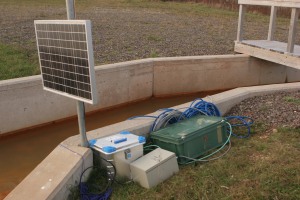Research
Tracer Test Course – January 25 & 26, 2012 | Download Flyer
Field Excercise – January 27, 2012
Course Material
- PDF File of Course Material
- MS Excel Sheet for Salt Tracer Dilution Test
- Rare Earth Elements (REEs) – Natural Tracers in Mine Waters
- Salts, Dyes, and Balls for the Soup – Tracer Tests in the Mining Environment
 What are Tracer tests
What are Tracer tests
Tracer tests are a means to investigate the flow and the hydrodynamic characteristics of ground or surface water. They are an established technique in hydrological and hydrogeological investigations used for over a century and are an important tool in water related investigations. There are two general types of tracer investigations commonly used today: natural and artificial tracer tests. In the first case, substances that are already contained in the water are analyzed and the results interpreted. In the second case, a substance is injected into the water and its time-concentration development is used to characterize the flow of the water. This course will focus on both, general aspects of tracer tests as well as the specific requirements for mine water tracer tests.
Course Contents
 Introduction
Introduction- Tracer types
- Natural
- Artificial
- Preparation of Tracer tests
- Legal Questions/Permission
- Implementation
- Evaluation
- Examples
- Surface/Ground Water
- Mine Water
Initially, the course will focus on an introduction to tracer tests. This introduction provides an overview of the use of tracers and which questions can be answered by means of tracer tests. Furthermore, the introduction covers the differences between natural and artificial tracer investigations and which substances can be used in each of those two cases. Most of the tracers used as natural or artificial tracers will be introduced and their advantages and disadvantages as well as prerequisites for their use discussed. In addition, the course will outline which analytical techniques for identifying those tracer substances should be employed.
 Planning and Preparation
Planning and Preparation
Key for a successful tracer investigation is a thorough planning and preparation of the test. Consequently, the course will introduce the necessities for a successful tracer test, such as selection of the appropriate tracer, calculation of the tracer amount to be used, accurate selection of sampling sites, and general requirements. Furthermore, a short introduction to the legal requirements for conducting a tracer test will be given. After a successful tracer test, the evaluation of the data is imperative; therefore, the course will examine different techniques to evaluate tracer test results and breakthrough curves. The different techniques will be discussed and the advantages and disadvantages of those methods will be outlined.
Case Studies
 At the end of the course several case studies will be presented. The case studies are the three typical situations for tracer tests: surface water, flow, and mine water tracer tests.
At the end of the course several case studies will be presented. The case studies are the three typical situations for tracer tests: surface water, flow, and mine water tracer tests.
Finally, a field exercise rounds out the course. During the field exercise, a flow measurement is conducted by means of a tracer dilution method.
Costs & Registration
For cost and registration information, click here
Our Symposium may also be of interest …
Mine Water Tracer Test Symposium (January, 24, 2012)
Sydney, Nova Scotia, Canada (CSEE, room CS-104)
Symposium, Course and Field Exercise organised organized by:
- Verschuren Centre for Sustainability in Energy & the Environment (CSEE) at Cape Breton University
- International Mine Water Association
- Nova Scotia Community College (NSCC)
- Unama’ki Economic Benefits Office (UEBO)




